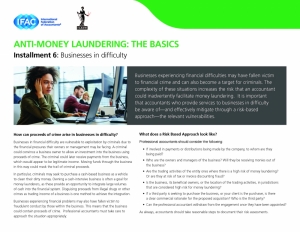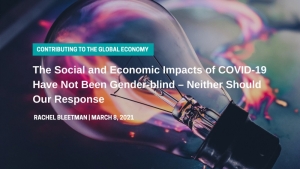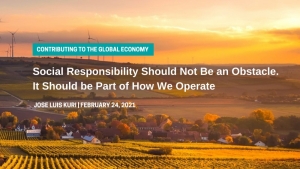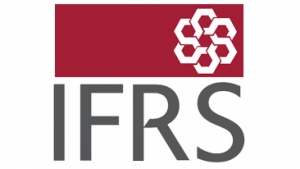عرض العناصر حسب علامة : التمويل
دراسة ماجستير: العواقب الاقتصادية لمستوى جودة الإفصاح وفقاً للتقارير المتكاملة: أدلة وقرائن عملية مبكرة من بيئة سوق الأسهم المصري
تمثل هدف القضية البحتية المطروحة من قبل الدراسة الحالية: في تقديم أدلة تفسيرية وقرائن عملية مبكرة من بيئة سوق الأسهم المصري، للعواقب الاقتصادية لمستوى جودة الإفصاح وفقاً للتقارير المتكاملة في عدة نواحي محاسبية قبل التطبيق الإلزامي لتلك التقارير في بيئة الأعمال المصرية.
معلومات إضافية
- البلد مصر
جوائز التمويل من أجل المستقبل 2021
باب التسجيل مفتوح لجوائز تمويل المستقبل 2021. تحتفي الجوائز بالقادة الماليين الملتزمين ببناء مستقبل مستدام ومعالجة قضايا البيئة والمجتمع والحوكمة من خلال التفكير المتكامل.
معلومات إضافية
- المحتوى بالإنجليزية 2021 is a crucial year for climate change. With COP26 being hosted by the UK in November, Finance for the Future will be celebrating climate action, alongside the categories that continue to recognise financial leadership in driving sustainable economies.
كيفية تسريع نمو الأعمال بمساعدة التكنولوجيا
لقد غيرت التطورات التكنولوجية التي تحققت على مر السنين الطريقة التي تتم بها الأعمال التجارية الى الأفضل، إن سوق العمل مليء بالمنافسة مما يجعل اكتساب ميزة تنافسية على منافسيك أولوية في بيئة اقتصادية صعبة. فتحقيق اقصى استفادة من أحدث التقنيات سيساعدك في تسريع نمو أعمالك حيث يمكنك تأسيس مكانة ثابتة.
إنفوجرافيك.. ماهي حاضنات الأعمال؟
الاتحاد الدولي للمحاسبين ومعهد المحاسبين القانونيين يطلقان الحلقة السادسة من السلسلة التعليمية: مكافحة غسيل الأموال
بالتعاون مع ICAEW، أصدر الاتحاد الدولي للمحاسبين (IFAC) الدفعة الرابعة من السلسلة التعليمية لمكافحة غسيل الأموال: الأساسيات: الأعمال في الصعوبة
كورونا وعدم المساواة بين الجنسين
معلومات إضافية
-
المحتوى بالإنجليزية
The Social and Economic Impacts of COVID-19 Have Not Been Gender-blind – Neither Should Our Response
RACHEL BLEETMAN | MARCH 8, 2021
COVID-19 and gender inequality
The COVID-19 pandemic has affected every corner of the world and all aspects of society, and the impacts of it will be felt for decades to come. One particular troubling consequence has been its devastating impact on gender inequality. The evidence is clear – the gender inequality gap is widening despite decades of progress that sought to close it.
As a result of the pandemic, women’s employment is 19% more at risk compared to men’s (UN Women 2020) and women are more likely than men to take on unpaid care and domestic work in households. In addition, it is estimated that global domestic violence cases are up around 20% (BBC 2020). For women in more marginalised communities – such as women with disabilities, LBTQ women and women from ethnic minorities, compounding factors have led to even greater discrimination and inequality.
Addressing the crisis
To tackle gender inequality, governments around the world can employ a critically important public policy tool known as gender-responsive budgeting (GRB) when designing COVID-19 economic recovery packages. GRB is defined by UN Women as a ‘process of assessing the implications for women and men of any planned action, including legislation, policies and programmes, in all areas and at all levels.’ It is importantly, not a process of allocating resources to men or women separately nor is it necessarily about allocating more resources than originally planned. Rather, it is a technical process of assessing existing budget policies to better evaluate their impacts on gender equality as well as being a high-level commitment to combat gender inequality. It is also not a new concept – it has been implemented in some form in over 80 countries (Stotsky 2020) since it was first developed in the 1980s.
To be most effective, gender-responsive budgeting techniques should be found throughout the policy and budget cycle. From the initial policy design, through to design and implementation and of course, in the auditing and evaluation stage. By adding a gendered perspective to each part of the cycle, policymakers and public finance professionals can ensure that they adequately account for the differing needs of men and women in a more holistic way. To promote the use of GRB in the COVID-19 response and to enable public sector finance professionals to employ the tool effectively, ACCA has developed a set of tools and resources to help the profession learn more about GRB and implement it wherever they are based.
An example of how to use gender-responsive budgeting
The UK’s Office of National Statistics releases data on unemployment disaggregated by both sex and sector each quarter. For August to October 2020, the unemployment figures were as follows:
74,000 people were classified as being unemployed in the construction sector. When filtered by sex, it shows that men accounted for 86% of that figure while 14% were women.
So, when designing a policy response aimed at tackling unemployment in the construction sector, it is critical that policymakers consider the gendered impact of what a construction job package might look like. It is clear from the sex-disaggregated data that the majority of end-users of this policy decision and budget allocation will be men. Therefore, subsequent or supplementary measures should be considered to ensure that female-dominated sectors are also prioritised in job retention or reskilling schemes to avoid women being overrepresented in the unemployment figures.
Additionally, exploring qualitative data can help better understand why women are so underrepresented in this sector – what barriers exist that have clearly prevented women from entering the construction sector? And for men, more data could probe thinking around, for example, the impacts of unemployment on mental health. Policymakers could also consider what policies could be used to equip those made unemployed with skills beyond construction. This initial process will encourage a more holistic approach to this particular package to fully understand its broader objectives outside of simply saving jobs. By assessing the impact of the policy on both men and women, policymakers can ensure that this policy response does not unintentionally exacerbate or perpetuate gender inequality.
Having explored the objectives, the next stage involves designing the policy and allocating the adequate resources to ensuring the policy will achieve its intended outcome. To do so, a number of useful techniques can be employed, for example –an equality impact assessment can be carried out to assess the expected impact on both women and men. The policy should also be subject to parliament scrutiny with a gendered lens. It is important to ensure that the way the policy is designed and measured will achieve the ultimate objective. For example, considering whether to use performance-based budgeting to measure outcomes or whether a zero-based budgeting approach would work better if this is a new policy objective.
At the implementation stage, considerations include whether line ministries have the training and capacity to implement the policy, and if sufficient resources have been allocated to achieve the objectives. Importantly, public finance professionals can use an expenditure tracking system to ensure actual spending meets planned spending – this will also improve the audit trail for the final evaluation stage. Finally, the finance professional can help ensure that the policy objective was met – this is where the vital role of auditors comes into play, to assess:
Was the intended objective met?
How mainstreamed was gender throughout the process?
And critically, what should be improved for the next cycle?
Supreme Audit Institutions have a critical role to play in ensuring that governments achieve both the objectives they lay out in budget statements, but also in ensuring governments meet their commitments to achieving the Sustainable Development Goals (SDGs)– in this case, SDG 5 on gender equality.
The central role of the finance profession
As the resources on ACCA’s website outlines, GRB can be implemented in any jurisdiction if certain conditions are in place. The public finance profession can play a key role, wherever they are in the world, to make GRB a reality and to shed a renewed light on COVID-19 and its impact on gender inequality. From ensuring data is disaggregated by sex, using that data to inform policymaking, designing budgets that can measure defined objectives and measuring progress made on achieving those objectives - the public finance profession is at the heart of GRB.
To learn more about what GRB is, where it can be found, how to implement it and what the profession can do to raise awareness of this policy tool, go to ACCA’s website to see our newly published resources and register here for our CPD webinar on GRB and the COVID-19 economic recovery.
سبب اعتبار المسؤولية الاجتماعية للشركات استثمارًا وليس تكلفة
معلومات إضافية
-
المحتوى بالإنجليزية
Social Responsibility Should Not Be an Obstacle. It Should be Part of How We Operate
JOSE LUIS KURI | FEBRUARY 24, 2021
Throughout time, an enterprise’s purpose has been associated with creating value for its shareholders. In today’s day and age, however, shareholders should be replaced by stakeholders in such definition. Actions and decisions of an enterprise have an impact in a wider population, defined as stakeholders. In our present world, a company or firm has responsibilities that extend beyond its profit-generating capabilities and into the effect it has in its environment and society. In the acknowledging and complying with this commitment, a firm is able to engage in corporate social responsibility (CSR), making it socially accountable — to itself, its stakeholders, and the general public.
In the past, there has been a dissociation between CSR and a company’s profitability. Sustainability has been seen as an obstacle, rather than an opportunity, mainly because of the costs associated with operating in a corporate and socially responsible way. In today’s business environment, however, CSR has proven to contribute to a firm’s profitability. As a result, the cost associated with becoming sustainable should not be regarded as a cost, but rather, as an investment. By engaging in corporate citizenship, and therefore sustainability, a company becomes well-equipped to deal with the uncertainty the future holds. The world is following a path where environmental, social, and governance (ESG) principles are at the forefront of business, and, therefore, a company that practices CSR has acquired a slot as a player in its industry’s future. A sustainable company is a more profitable company: sustainability leads to longevity, and longevity leads to more profits.
In addition to this and with a special relevance to publicly traded companies, being classified as a company with a CSR business model facilitates the collection of capital and funds. For example, Larry Fink, CEO of BlackRock, recently revealed in his letter to shareholders, that the firm is placing ESG at the forefront of its investing strategy. BlackRock is a giant in the investment and financial industry, with almost US$7.5 trillion in assets under management.
Another company that has placed sustainability at the core of its business is MSCI. MSCI is a leading global provider of indexes, and its focus on ESG indexes has benchmarked sustainable companies and has facilitated investment vehicles for them to receive funds. These strategies, employed by huge players in the finance industry, means that the modern investor is recognizant of the social impact and environmental footprint of companies, and is increasingly convinced that superior returns accompany sustainability.
Accountancy is in a frontline position to prevent, detect and correct any non-compliances in an enterprise’s social responsibility. The role of an accountant in an organization is to compile, measure, and report data related to its business operations. These functions are correctly associated with the organization’s financial information; however, the role of an accountant goes beyond solely the analysis of a company’s finances. Accountants are equally qualified to perform these functions on the information surrounding an organization’s social responsibility and engage in social accounting. By continuously monitoring features of the firm, like transparency, corporate governance, and carbon emission, an accountant can implement the required changes in the organization’s internal controls and guide it in a sustainable direction. Ultimately, it can be the accountant’s responsibility to identify the risks in a company’s business environment, quantify their impact, and mitigate their effects. This equally applies to the social risks forming part of the same business environment.
Based on the importance of sustainability and corporate social governance in today’s business world, the ever-increasing relevance it will continue to gain in the future, and the qualities of the accounting profession, social accounting is a defining quality of what makes up the accountant of tomorrow. It is the profession’s responsibility to take ownership of this category of accounting and continue to enhance decision-making and guide companies in the right direction, now using a wider spectrum of responsibilities. Despite having their origin and foundation in economic responsibilities to their shareholders, companies are interwoven with society and the environment, and now acknowledge social and environmental responsibilities as part of their purpose. It is necessary for the accountancy profession to recognize this and continue to evolve while continuing to be the backbone of every business.
جمعية المحاسبين القانونيين المعتمدين (ACCA) تختار رئيسًا جديدًا
ملخص اجتماع اللجنة الاستشارية المشتركة لأسواق رأس المال و المُعدِّين العالميين لشهر أكتوبر 2020
يتوفر ملخص اجتماع اللجنة الاستشارية المشتركة لأسواق رأس المال ومنتدى المُعدِّين العالميين لشهر أكتوبر 2020










